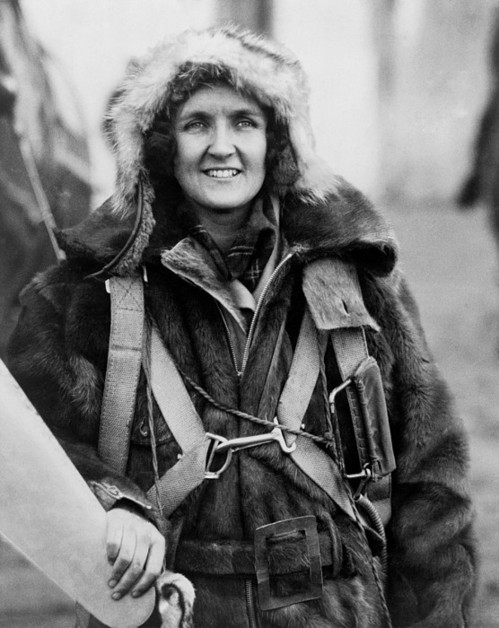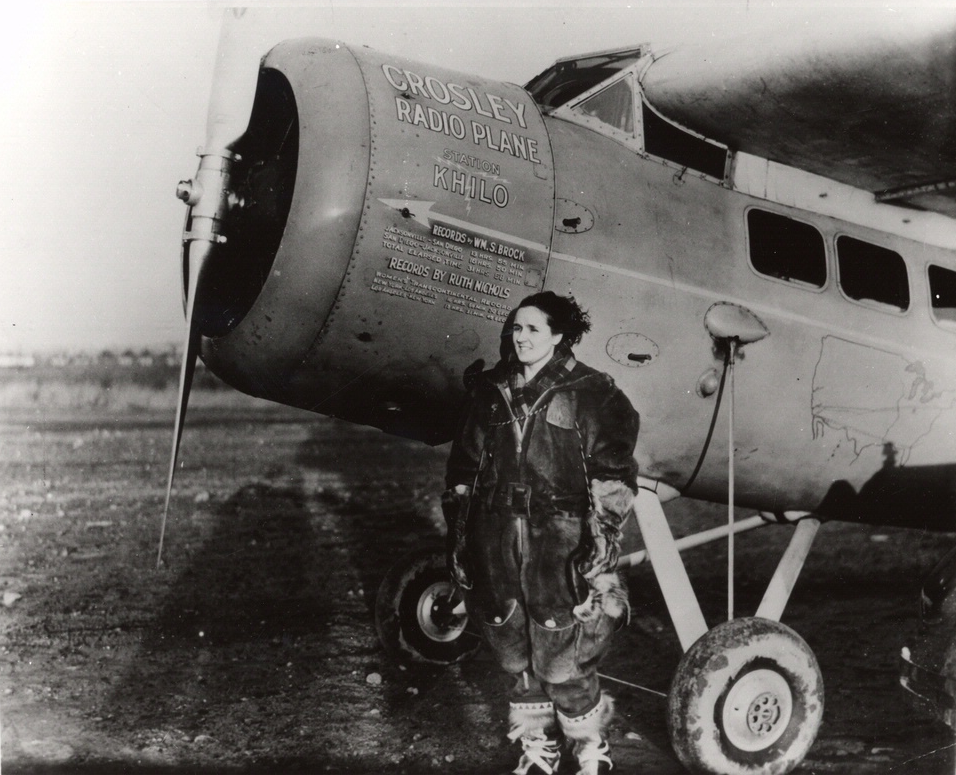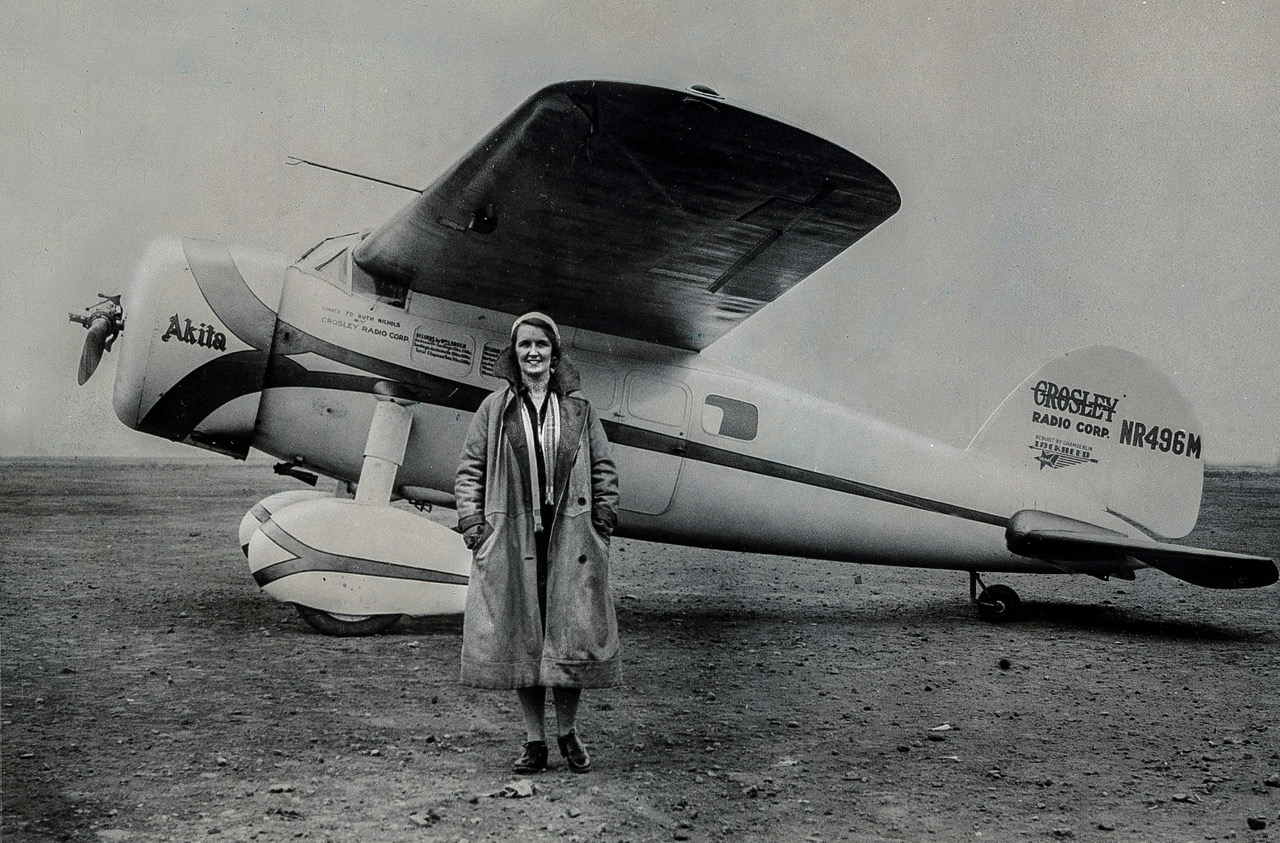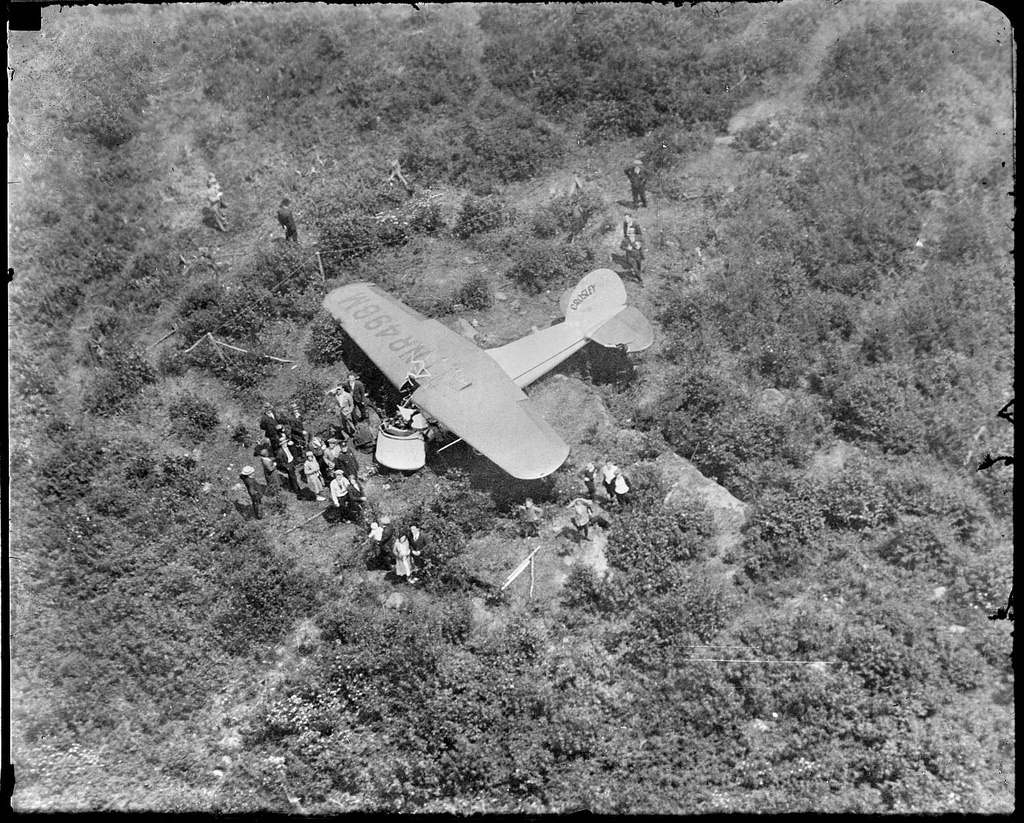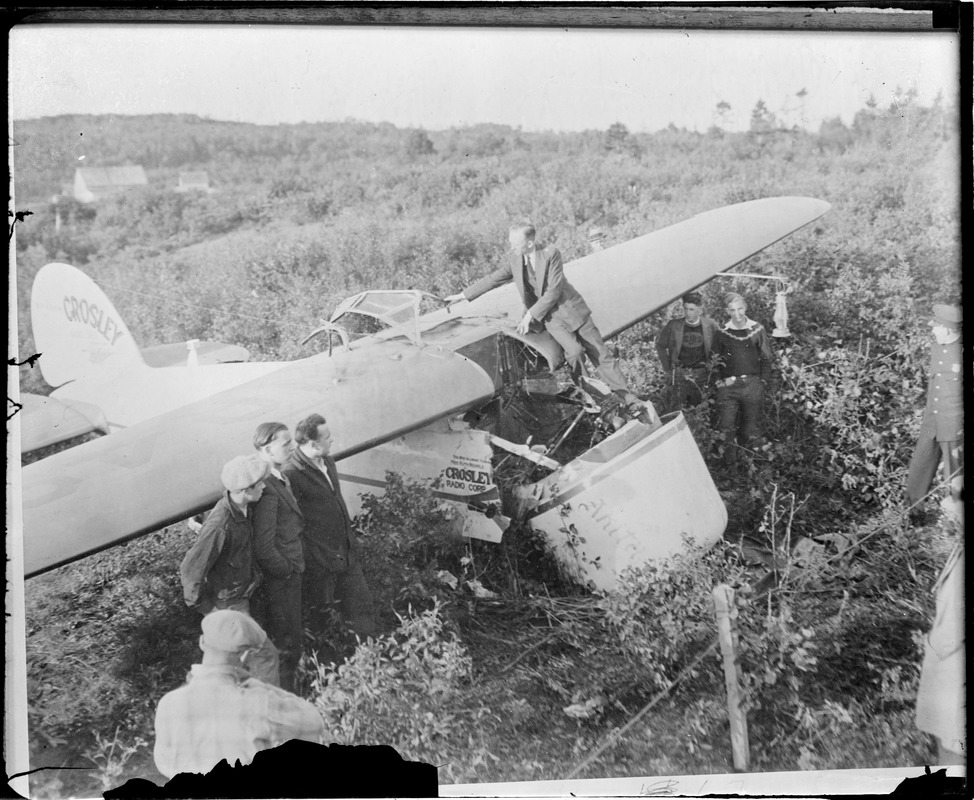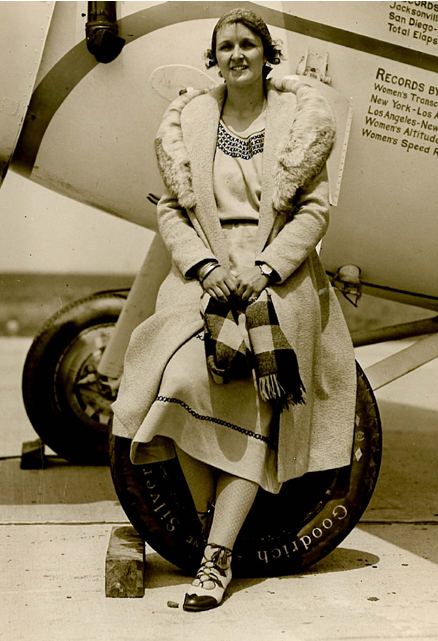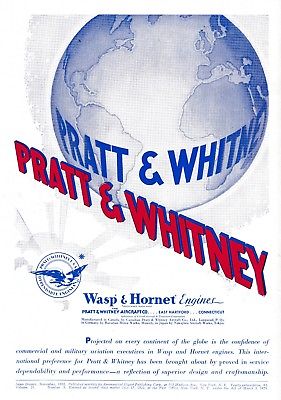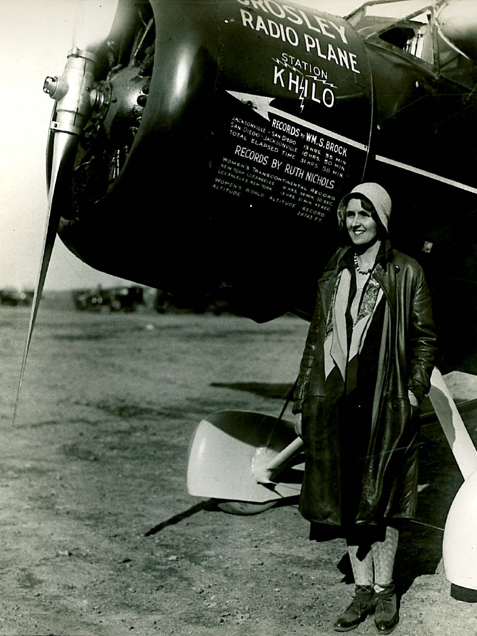
 13 April 1931: Ruth Rowland Nichols set a Fédération Aéronautique Internationale (FAI) World Speed Record of 338.99 kilometers per hour (210.64 miles per hour) over a 3 kilometer course at Carlton, Minnesota.¹
13 April 1931: Ruth Rowland Nichols set a Fédération Aéronautique Internationale (FAI) World Speed Record of 338.99 kilometers per hour (210.64 miles per hour) over a 3 kilometer course at Carlton, Minnesota.¹
Nichols’ airplane was a 1928 Lockheed Model 5 Vega Special, serial number 619, registered NR496M, and owned by Powell Crosley, Jr. He had named the airplane The New Cincinnati.
Ruth Nichols Sets Air Mark With 210.65 Miles an Hour
New York Girl on One Dash Attains 226.88 Miles Over measured Course at Detroit
Detroit, April 13.—All records for airplane speed with a woman pilot were shattered today when Miss Ruth Nichols, Rye, New York, raced over the three kilometer course at Grosse Ile an an average speed of 210.65 miles an hour. Amelia Earhart Putnam formerly held the record at 181.1 miles per hour.²
Miss Nichols, using a Lockheed Vega plane, powered with a Wasp motor, made four flights over the measured course. On one dash she attained a speed of 226.88 miles an hour.
Hazardous Flight
The course, one of these recognized in the United States, is laid out along the Detroit, Toledo and Ironton Railroad Line. In addition to the rails for guide lines, white strips of cloth marked the route.
After a few warm-up turns over the course Miss Nichols signalled she was ready. The flight was doubly hazardous because she was forced to fly extremely low.
The plane used was the same in which she set the altitude record recently eclipsed by Miss Elinor Smith.³
Miss Nichols, who in the last few months had shattered about all the aviation records there are for women—although her altitude record was broken by Elinor Smith—was the main feature of the aviation show.
There was a good crowd to cheer the tall, smiling Rye woman when she climbed from her record-breaking plane.
“It really isn’t anything to do,” she said. “All a girl needs is a good ship and nerve.”
May Fly the Atlantic
She sensed her speed, followed strips of white cloth which outlined teh course, and in a very matter of fact way established the record.
She was asked concerning reports she planned a transatlantic flight, and answered:
“Fly the ocean? Well, why shouldn’t a girl do the trick?” she said. “There is no reason why one shouldn’t be able. The main requirement is a good ship, I think. If I get one, I may do it. This plane is the same one in which I set a record of 30 hours, 12 minutes for a flight from Los Angeles to New York and return, It has flown many thousands of miles in addition, and was used in the altitude flight. You saw what it did today.”
When Miss Nichols’ plane reached its top speed of 226.88 miles an hour she was but 51.60 miles behind the world’s record for land planes, held by Adjutant Bonnett, of France, who went 278.48.
Inside the mammoth aviation show hangar today air enthusiasts discovered they were walking about the aisles with Henry Ford.
The motor car magnate visited the show with W. B. Mayo, Ford engineer, and his two grandsons, Henri II and Benson Ford. Ford viewed the exhibit of his own giant liners and then inspected other exhibits.
He took particular interest in new inventions displayed. He was in the hangar an hour and a half before his presence became known generally.
Yesterday 18,000 went through the gates, while thousands more stood about City Airp0ort to watch the planes. They say among other things the unofficial setting of a new altitude mark by light planes.
Kenneth Scholter, 19-year-old pilot from Hudson, Ohio, attained 19,500 feet ina tiny Aeronca monoplane, powered by a 30 horsepower motor yesterday.
—The Brooklyn Daily Times, Monday, 13 April 1931, Page 1, Columns 2–3
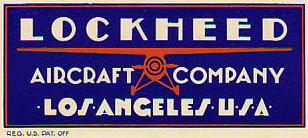 Built by the Lockheed Aircraft Company, Burbank, California, the Vega was a single-engine high-wing monoplane with fixed landing gear. It was flown by a single pilot in an open cockpit and could be configured to carry four to six passengers.
Built by the Lockheed Aircraft Company, Burbank, California, the Vega was a single-engine high-wing monoplane with fixed landing gear. It was flown by a single pilot in an open cockpit and could be configured to carry four to six passengers.
The Lockheed Vega was a very state-of-the-art aircraft for its time. The prototype flew for the first time 4 July 1927 at Mines Field, Los Angeles, California. It used a streamlined monocoque fuselage made of molded plywood. The wing and tail surfaces were fully cantilevered, requiring no bracing wires or struts to support them. The fuselage was molded laminated plywood monocoque construction and the wing was cantilevered wood.
The Model 5 Vega is 27 feet, 6 inches (8.382 meters) long with a wingspan of 41 feet (12.497 meters) and overall height of 8 feet, 2 inches (2.489 meters). Its empty weight is 2,595 pounds (1,177 kilograms) and gross weight is 4,500 pounds (2,041 kilograms).
 Nichols’ airplane was powered by an air-cooled, supercharged 1,343.804-cubic-inch-displacement (22.021 liter) Pratt & Whitney Wasp C nine-cylinder radial engine with a compression ratio of 5.25:1. It was rated at 420 horsepower at 2,000 r.p.m. at Sea Level, burning 58-octane gasoline. The engine drove a two-bladed controllable-pitch Hamilton Standard propeller through direct drive. The Wasp C was 3 feet, 6.63 inches (1.083 meters) long, 4 feet, 3.44 inches (1.3-7 meters) in diameter and weighed 745 pounds (338 kilograms).
Nichols’ airplane was powered by an air-cooled, supercharged 1,343.804-cubic-inch-displacement (22.021 liter) Pratt & Whitney Wasp C nine-cylinder radial engine with a compression ratio of 5.25:1. It was rated at 420 horsepower at 2,000 r.p.m. at Sea Level, burning 58-octane gasoline. The engine drove a two-bladed controllable-pitch Hamilton Standard propeller through direct drive. The Wasp C was 3 feet, 6.63 inches (1.083 meters) long, 4 feet, 3.44 inches (1.3-7 meters) in diameter and weighed 745 pounds (338 kilograms).
“Ruth Nichols was the only woman to hold simultaneously the women’s world speed, altitude, and distance records for heavy landplanes. She soloed in a flying boat and received her pilot’s license after graduating from Wellesley College in 1924, becoming the first woman in New York to do so. Defying her parents wishes to follow the proper life of a young woman, in January 1928 she flew nonstop from New York City to Miami with Harry Rogers in a Fairchild FC-2. The publicity stunt brought Nichols fame as “The Flying Debutante” and provided headlines for Rogers’ airline too. Sherman Fairchild took note and hired Nichols as a northeast sales manager for Fairchild Aircraft and Engine Corporation. She helped to found the Long Island Aviation Country Club, an exclusive flying club and participated in the 19,312-meter (12,000-mile) Sportsman Air Tour to promote the establishment of clubs around the country. She was also a founder of Sportsman Pilot magazine. Nichols set several women’s records in 1931, among them a speed record of 339.0952 kph (210.704 mph), an altitude record of 8,760 meters (28,743 feet), and a nonstop distance record of 3182.638 kilometers (1,977.6 miles). Her hopes to become the first woman to fly the Atlantic Ocean were dashed by two crashes of a Lockheed Vega in 1931, in which she was severely injured, and again in 1932. In 1940, Nichols founded Relief Wings, a humanitarian air service for disaster relief that quickly became an adjunct relief service of the Civil Air Patrol (CAP) during World War II. Nichols became a lieutenant colonel in the CAP. After the war she organized a mission in support of the United Nations Children’s Fund (UNICEF) and became an advisor to the CAP on air ambulance missions. In 1958, she flew a Delta Dagger at 1,609 kph (1,000 mph) at an altitude of 15,544 meters (51,000 feet). A Hamilton variable pitch propeller (which allowed a pilot to select a climb or cruise position for the blades), from her Lockheed Vega is displayed in the Golden Age of Flight gallery. Nichols’ autobiography is titled Wings for Life.”
— Smithsonian Institution National Air and Space Museum, Women In Aviation and Space History, The Golden Age of Flight.
¹ FAI Record File Number 12282
² FAI Record File Number 12326: 291.55 kilometers per hour (181.16 miles per hour), Detroit, Michigan, U.S.A., 5 July 1930
³ FAI Record File Number 12228: 8,761 meters (27,743.44 feet), Jersey City Airport, New Jersey, U.S.A., 6 March 1931
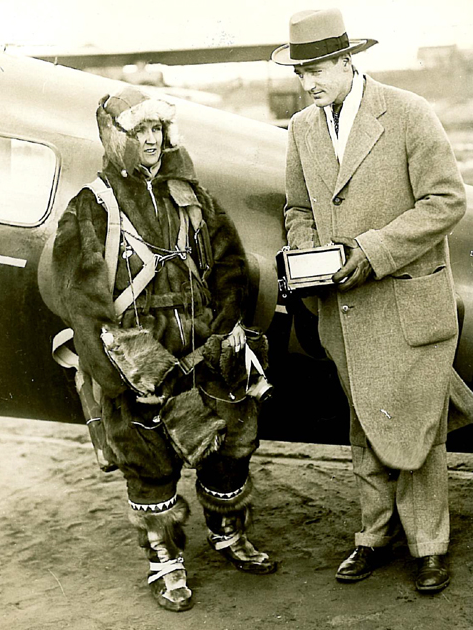
© 2024, Bryan R. Swopes
